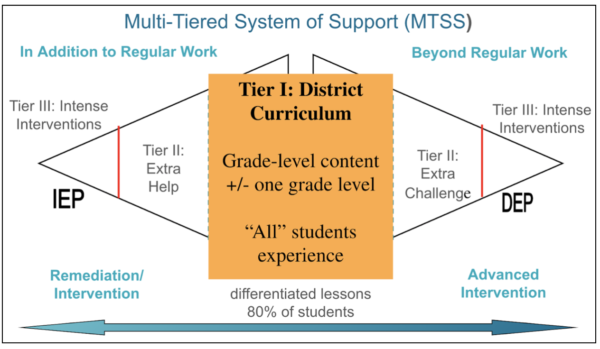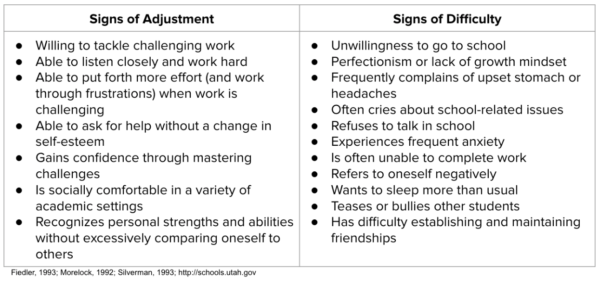Supporting Advanced Learning Within a Multi-Tiered System of Supports
What is MTSS and How Does Advanced Learning Fit Within the MTSS Framework?
A multi-tiered system of support, or MTSS, is a framework with a tiered infrastructure that uses data to help match academic, social-emotional, and behavioral assessment and instructional resources to each and every student’s needs. Although it’s understood that MTSS is for all students, many are surprised to hear that MTSS is also meant to support students with advanced learning needs.
As we know, there is often a huge chasm between theory and practice. When I worked in a school district, interventionists who supported students with advanced learning needs were often not included in weekly MTSS meetings. Many times I heard teachers and administrators say things such as: “We need to focus on our students who struggle” or “How can that student be an advanced learner if he has poor grades or is not performing quite at grade level?”
Like all students, students with advanced learning needs require support (enrichment and extension) that bolsters and extends learning. Just as we do with students who struggle and need interventions to achieve grade-level standards, schools need to track interventions and supports, progress monitor, and document advanced learning support.
What is Advanced Learning?
Similar to how each state has their own definition of MTSS, each state has their own definition of what constitutes advanced learning, often referred to as gifted and talented education. My career in education took place in Wisconsin, where students who require enrichment can be identified in 5 Domains: general intellectual, creativity, leadership, specific academic areas, or the visual and performing arts. However, while the state statute exists and requires schools to service students with advanced learning needs, the statue is thin and not specific (Wisconsin Statutes § 118.35). Additionally, there is little to no funding for gifted and talented education. Finally, educators often do not receive instruction in how to support students with advanced learning needs. In fact, in my home state, the Gifted and Talented license is optional and programs that offer this credential are continuously being cut.
Although most educators can probably picture an archetypical advanced learner, the characteristics of an advanced learner are varied. Some of the most common characteristics are: extraordinary vocabulary; exceptional understanding of complex or abstract ideas; early development in math and language tasks - knowledge and behaviors present on their own (not taught or coached); advanced sense of humor; understanding of jokes and puns; heightened sensitivity to feelings and ideas; amazing curiosity; questions and touches almost everything; recalls facts easily; is very well-informed about one or more topics; shows keen insight into cause-effect relationships; exhibits exceptional ability to solve problems; and has a phenomenal memory (Montana Office of Public Instruction). While all of these characteristics can be indicators of an advanced learner, this list often excludes Twice-Exceptional Students, English Language Learners with advanced learning needs, and students who struggle socially, emotionally, and behaviorally.
Supports and Instructional Practices
It is important to remember that any student, at any time, may require advanced learning support. There are many high-leverage, low-cost ways that district and school leaders can support students with advanced learning needs. If your school already has a solid foundation for the MTSS framework, consider ways that you can leverage this system to support advanced learning when it comes to tiers of support, social-emotional support, and district and professional development structures. Below are some examples.
Tiers of Support
When we think of the traditional model of MTSS, we immediately call to mind the pyramid or triangle with three tiers of support. These tiers of support also apply to students who require enrichment. Remember that tiers of support are fluid and will change with the needs of each individual child. Just because a student requires Tier 3 supports now does not mean that they will always require that level of support in the future.
The MTSS tiers are:
- Tier 1 – Universal Instruction: The high-quality classroom instruction that all students receive. This tier encompasses best practices, differentiated instruction, and is constantly refined by what is working at Tier 2 and Tier 3. Typically, districts aim to see 80-90% of students in Tier 1.
- Tier 2 – Targeted, Group Interventions The evidence-based supports provided to students who are identified as struggling. Tier 2 interventions are typically implemented in small group settings, based on a similar need identified through assessment and for the sake of systematic efficiency. Districts typically expect to see 5-15% of students in Tier 2.
- Tier 3 – Intensive, Individualized Interventions The supports implemented for students not responding to Tier 2 supports. Tier 3 supports provide more frequent, intense, and individualized interventions. Usually, districts expect to see 1-5% of students in Tier 3.
McBree and Peters present the MTSS framework as a diamond where students move fluidly along the spectrum of support. In this representation (see below), students are move along a support spectrum and accessing supports that are “in addition to regular work” (remediation or extra help) and “beyond regular work” (enrichment or extra challenge). A student may require an IEP (Individualized Education Program) while also needing to have a DEP (Differentiated Education Plan) that documents and plans out what additional enrichment is required to support their advanced learning needs. Additionally, if you are at all like me, you might have been gifted in English Language Arts and probably required extra help to understand Algebra. (I’m more of a Stats person anyway!)

2016, McBree and Peters
Social-Emotional Support
Along with academic support, it’s important to remember that students with advanced learning needs often experience social and emotional challenges in school. Perfectionism and underachievement are common signs of needing social-emotional support. As with all students, teachers should practice a growth mindset with students and be aware of how they are praising students (Utah Office of Public Instruction).
Additionally, teachers and parents need to be aware of signs of adjustment as well as signs of difficulties:

Professional Development, District Structures, and Classroom-Level Instructional Supports
When I was in district, the highest leverage points were to require all staff to attend a “Welcome Back” professional development (PD) session on how to support students with advanced learning needs. Additionally, we provided our advanced learning interventionists with monthly PD on best practices. Finally, we had our advanced learning interventionists attend Instructional Coaching PD that was provided district-wide to all instructional coaches. Given the structure of our district, we were able to have a 0.5 advanced learning interventionist at each K-8 building where they worked with students with Tier 2 needs and also served as instructional coaches.
In addition to professional development, my district focused on building out extensions within our curricular scopes. We specifically built out extensions for grades K-8 in ELA and Social Studies and for K-5 in Math. We also utilized heterogeneous groupings, conferring protocols, and provided the advanced learning interventionists with PD on Webb’s Depth of Knowledge and how to develop more in-depth assignments.
At the classroom-level, in addition to quality differentiated instruction, there are many instructional practices that can be used to support advanced learners. Some of the highest leverage instructional practices include: Choice Boards/Tic-Tac-Toe Boards, compacting, extensions, independent study, open-ended assignments, pre-testing students, and providing tiered assignments.
Conclusion
Students with advanced learning needs require support to bolster their learning, and MTSS is the system through which students with advanced learning needs should be identified and supported. It is time to move towards supporting the whole child, moving away from tethering students to tiers of support or a label, and shift to focusing on how students can move fluidly in and out of the support that they require throughout their K-12 education.
Illuminate supports districts nationwide in effectively serving advanced learners through MTSS, providing intervention tracking, progress monitoring, support documentation, and more. To learn more, reach out.
To learn more about MTSS, download our MTSS Essentials: Data-Informed Decisions to Support Each Student eBook.
*****
Illuminate Education partners with K-12 educators to equip them with data to serve the whole child and reach new levels of student performance. Our solution brings together holistic data and collaborative tools and puts them in the hands of educators. Illuminate supports over 17 million students and 5200 districts/schools.
Ready to discover your one-stop shop for your district’s educational needs? Let’s talk.

